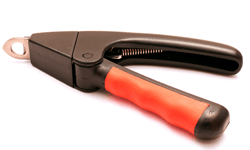Although not particularly enjoyable, nail trimming is necessary. The German Shorthaired Pointer is an active dog, and nails that are too long can break, split, or even tear, making activity difficult or painful. If the nails are too long, the dog will rock his weight back on his paws so there is less pressure on the nails, which causes problems with movement and can flatten the foot.
Dogs don’t particularly like their paws being held, and they definitely do not like them squeezed, although holding a clipper in your other hand seems to accentuate this dislike. The more you practice trimming nails while your dog is a puppy and make it a positive experience, the better your dog will behave when he is full grown.
Practice Makes Perfect
The less you linger and belabor the trimming process, the less stressed your dog will be. If you can cut your German Shorthaired Pointer’s nails swiftly and accurately, you will minimize your dog’s chances of getting “wiggly” while his nails are being trimmed. Don’t, however, go so fast that you make a lot of mistakes and begin to quick your dog’s toenails.
To accomplish this, it helps to get as much practice time as possible. One of the ways you can do this is to practice nail trimming without actually trimming the nail, including holding the clipper against the nail. The earlier you start this with your German Shorthaired Pointer, the better. These practice sessions are also a great way to heap praise and love on your GSP.
With enough practice of this kind, your GSP will learn to be well behaved while his paws are being handled, and will
look forward to his love and treats, too. Don’t fuss if you “quick” a nail; act as if it’s “nothing.” If you can keep moving on and continue clipping the rest of the nails, do so. But if you need to, take care of the quicked nail first.
Depending on how fast your GSP’s nails grow, you may have to trim them every few weeks. If you are going to show your GSP in conformation classes, you will be expected to have your dog’s nails very short and polished. (This will require more frequent trimming.) In field work, the nails should be a healthy, functioning length but don’t need to be particularly short.
What do you do when you can’t see the quick? This can be a problem with GSPs, as many of them have some, or all, black nails, and you can’t see where the quick ends. (Clear nails enable you to easily see the pink quick through the nail.) If you turn the paw over, you will see an oval-shaped structure at the bottom of the nail. where the quick is. Cut just past it, to avoid cutting into the quick.
Nail Trimming Tools
There are several options for trimming nails, as listed below.
- The “guillotine” clipper: This clipper has a place to put the nail through and “hold” it while the blade slides along a track and slices it off.
- The “scissors” clipper: This clipper has two blades that close together like scissors blades. Often there is a “guard” that can be used to keep from cutting too much nail at one time.
- The grinder: Although there are dedicated electric or battery-powered grinders for pet toenail trimming, most professionals just use a Dremel tool with a fine grind tip. Grinding has the benefit of being able to smooth and polish, in addition to allowing you to avoid quicking the nail. However, you have to be careful not to give your dog a “hot paw”—because these can really heat up if you aren’t careful. Also, your dog will have to get used to the sound, smell, and overall grinding sensation—some dogs really worry and resist this tool’s use at first. Use the same strategies as with acclimating to a toenail clipper and work without grinding, rewarding for non-wiggly behavior and easing your Shorthair Pointer into the grinding routine.
Ways to Stop Bleeding Quickly
If you quick your dog, there are several options. You can dip the nail into a powdered product such as Quik Stop, which will clot the flow of blood. You can use a styptic pencil on the quicked nail. You can also apply pressure with a paper towel until the bleeding has stopped. After you’ve stopped the bleeding, don’t let your dog run around too soon, as the clot needs to set a little while so it doesn’t dislodge. This would be a good time to give him a yummy chew and allow him some quiet time in his crate.
Helpful Tip: Some breeders swear by cutting the nail with a “guillotine” or vertical cutting clippers. Some clippers have a scissors motion that lends itself to sideways cutting. Some breeders, however, think that cutting sideways causes discomfort in large dog nails, but the “guillotine” style of cutting does not.
If you would like to try this, and have a scissors-style nail cutter, you can hold it sideways so it is still cutting “up and down”. Key, however, is that whatever style clippers you use, they are the appropriate size for the dog, and they are well made and very, very sharp. Dull blades of any type of clipper will crumble and splinter a nail as opposed to cutting it cleanly.

